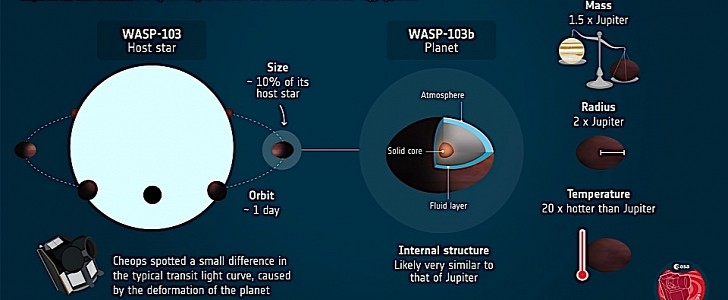Stars are some of the most powerful, extreme, and important objects in our Universe. Extremely widespread (there is an estimated 200 billion trillion of them out there), they have the power to keep planets in check and are essential to the existence of life, but also very destructive due to their sheer size, mass, and temperature.
The effects stars have on their surroundings have long been at the center of humanity’s space exploration efforts, and on more than one occasion we were left in awe at what they can do. And today’s ESA announcement is exactly such an occasion.
Back in 2019, the European Space Agency launched the CHEOPS mission. It’s not meant to study stars, but exoplanets (CHEOPS stands for CHaracterising ExOPlanets Satellite), but as you’ll see below, you can’t really have one without the other.
The main photo of this pic shows a planet called WASP-103b, orbiting the WASP-103 star in the Hercules constellation, 35 light-years away from Earth. The pic is an illustration of the findings CHEOPS came up with while looking at the planet, and it’s simply stunning.
Its shows a football-shaped planet (ESA, being European, calls it rugby ball-shaped), orbiting a star “200 degrees hotter and 1.7 times larger than the Sun," and marking an important moment in the history of space exploration - ”the first time that the deformation of an exoplanet has been detected.”
Now, people did not actually see the planet with their eyes, because that’s not exactly how telescopes work. Instead, they measured the dip in light caused when a planet passes in front of its star to detect it.
Its shape was revealed thanks to the “high precision of Cheops together with its pointing flexibility,” which allowed scientists here back on Earth “to detect the minute signal of the tidal deformation of WASP-103b.”
After crunching the numbers, ESA concluded the planet has a mass distribution similar to that of Jupiter, but twice the radius, meaning it “must be very inflated due to heating from its star and maybe other mechanisms.”
Now that it found something cool to look at, ESA plans to wait for the Webb telescope to be in position and operational to take a more in-detail look at WASP-103b.
This new data might also reveal more about the “mysterious motion” of the planet that seems to be taking it further and further away from its star.
Back in 2019, the European Space Agency launched the CHEOPS mission. It’s not meant to study stars, but exoplanets (CHEOPS stands for CHaracterising ExOPlanets Satellite), but as you’ll see below, you can’t really have one without the other.
The main photo of this pic shows a planet called WASP-103b, orbiting the WASP-103 star in the Hercules constellation, 35 light-years away from Earth. The pic is an illustration of the findings CHEOPS came up with while looking at the planet, and it’s simply stunning.
Its shows a football-shaped planet (ESA, being European, calls it rugby ball-shaped), orbiting a star “200 degrees hotter and 1.7 times larger than the Sun," and marking an important moment in the history of space exploration - ”the first time that the deformation of an exoplanet has been detected.”
Now, people did not actually see the planet with their eyes, because that’s not exactly how telescopes work. Instead, they measured the dip in light caused when a planet passes in front of its star to detect it.
Its shape was revealed thanks to the “high precision of Cheops together with its pointing flexibility,” which allowed scientists here back on Earth “to detect the minute signal of the tidal deformation of WASP-103b.”
After crunching the numbers, ESA concluded the planet has a mass distribution similar to that of Jupiter, but twice the radius, meaning it “must be very inflated due to heating from its star and maybe other mechanisms.”
Now that it found something cool to look at, ESA plans to wait for the Webb telescope to be in position and operational to take a more in-detail look at WASP-103b.
This new data might also reveal more about the “mysterious motion” of the planet that seems to be taking it further and further away from its star.






